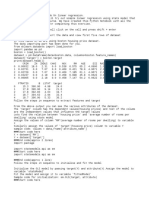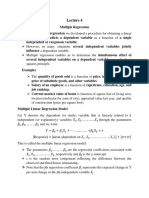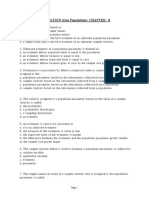Lab Assignment 2
Uploaded by
yashutank46Lab Assignment 2
Uploaded by
yashutank46In [1]: # Q1. Write the python script to solve the following problem.
Find the MSE, RMSE, MAE, SSE and R2 Error.
import numpy as np
from sklearn.linear_model import LinearRegression
from sklearn.metrics import mean_squared_error, mean_absolute_error, r2_score
weeks = np.array([1, 2, 3, 4, 5])
sales = np.array([1.2, 1.8, 2.6, 3.2, 3.8])
weeks = weeks.reshape(-1, 1)
model = LinearRegression()
model.fit(weeks, sales)
week_7 = np.array([[7]])
week_12 = np.array([[12]])
sales_pred_7 = model.predict(week_7)
sales_pred_12 = model.predict(week_12)
print(f"Predicted sales for the 7th week: {sales_pred_7[0]:.2f} thousand")
print(f"Predicted sales for the 12th week: {sales_pred_12[0]:.2f} thousand")
mse = mean_squared_error(sales, model.predict(weeks))
rmse = np.sqrt(mse)
mae = mean_absolute_error(sales, model.predict(weeks))
sse = np.sum((sales - model.predict(weeks))**2)
r2 = r2_score(sales, model.predict(weeks))
print(f"\nMean Squared Error (MSE): {mse:.4f}")
print(f"Root Mean Squared Error (RMSE): {rmse:.4f}")
print(f"Mean Absolute Error (MAE): {mae:.4f}")
print(f"Sum of Squared Errors (SSE): {sse:.4f}")
print(f"R-squared (R2): {r2:.4f}")
Predicted sales for the 7th week: 5.16 thousand
Predicted sales for the 12th week: 8.46 thousand
Mean Squared Error (MSE): 0.0024
Root Mean Squared Error (RMSE): 0.0490
Mean Absolute Error (MAE): 0.0400
Sum of Squared Errors (SSE): 0.0120
R-squared (R2): 0.9973
In [2]: # Q2. Write Python script to find the statistics of the given data (take your own) such as Mean, Median, Standard deviation, Variance and mode.
import numpy as np
from scipy import stats
data = np.array([15, 22, 31, 35, 47, 51, 63, 74, 82, 92])
mean_value = np.mean(data)
median_value = np.median(data)
std_dev = np.std(data)
variance = np.var(data)
mode_result = stats.mode(data)
print(f"Data: {data}")
print(f"Mean: {mean_value:.2f}")
print(f"Median: {median_value}")
print(f"Standard Deviation: {std_dev:.2f}")
print(f"Variance: {variance:.2f}")
print(f"Mode: {mode_result.mode[0]} (occurs {mode_result.count[0]} times)")
Data: [15 22 31 35 47 51 63 74 82 92]
Mean: 51.20
Median: 49.0
Standard Deviation: 24.75
Variance: 612.36
Mode: 15 (occurs 1 times)
C:\Users\Yashu\AppData\Local\Temp\ipykernel_11676\180578166.py:9: FutureWarning: Unlike other reduction functions (e.g. `skew`, `kurtosis`), the default behav
ior of `mode` typically preserves the axis it acts along. In SciPy 1.11.0, this behavior will change: the default value of `keepdims` will become False, the `
axis` over which the statistic is taken will be eliminated, and the value None will no longer be accepted. Set `keepdims` to True or False to avoid this warni
ng.
mode_result = stats.mode(data)
In [3]: # Write a python script to implement the KNN Algorithm over given data set and find the class of (5.5. 5.5).
from sklearn.neighbors import KNeighborsClassifier
data = [
[2, 2, 'Car'],
[5, 3.5, 'Car'],
[3.5, 4.5, 'Car'],
[4.5, 2, 'Car'],
[4.5, 6.5, 'Car'],
[2.5, 4.5, 'Truck'],
[6.5, 5.5, 'Truck'],
[6.5, 2.5, 'Truck'],
[7.5, 3.5, 'Truck'],
[3, 2, 'Truck'],
[4.5, 7, 'Truck'],
[6, 7, 'Bus'],
[6.5, 4.5, 'Bus'],
[7.5, 6.5, 'Bus'],
[5, 3.5, 'Bus'],
[5.5, 5.5, 'Bus']
]
X = [row[:2] for row in data]
Y = [row[2] for row in data]
knn = KNeighborsClassifier(n_neighbors=3)
knn.fit(X, Y)
point_to_classify = [[5.5, 5.5]]
predicted_class = knn.predict(point_to_classify)
print(f"The class of the point (5.5, 5.5) is: {predicted_class[0]}")
The class of the point (5.5, 5.5) is: Bus
In [ ]:
You might also like
- MUNAR - Linear Regression - Ipynb - ColaboratoryNo ratings yetMUNAR - Linear Regression - Ipynb - Colaboratory30 pages
- Evaluation Metrics for Your Regression Model - Analytics VidhyaNo ratings yetEvaluation Metrics for Your Regression Model - Analytics Vidhya6 pages
- SiddharthShah 1032221195 DivC 50 DL LabAssignment2No ratings yetSiddharthShah 1032221195 DivC 50 DL LabAssignment27 pages
- An Introduction to Stadistical Learning-129-140-1-8No ratings yetAn Introduction to Stadistical Learning-129-140-1-88 pages
- Know Your Dataset: Season Holiday Weekday Workingday CNT 726 727 728 729 730No ratings yetKnow Your Dataset: Season Holiday Weekday Workingday CNT 726 727 728 729 7301 page
- Assesing Performance of Regression-Error MeasuresNo ratings yetAssesing Performance of Regression-Error Measures5 pages
- Introduction To Econometrics: Bivariate Regression ModelsNo ratings yetIntroduction To Econometrics: Bivariate Regression Models21 pages
- Regression: Introduction: Basic Idea: Use Data To Identify Among Variables and Use These Relationships To MakeNo ratings yetRegression: Introduction: Basic Idea: Use Data To Identify Among Variables and Use These Relationships To Make23 pages
- Data Science Interview Questions and Answers For 2020No ratings yetData Science Interview Questions and Answers For 202020 pages
- Data Science Interview Questions and Answers For 2020 PDFNo ratings yetData Science Interview Questions and Answers For 2020 PDF20 pages
- Vertopal.com C1 W2 Lab02 Multiple Variable SolnNo ratings yetVertopal.com C1 W2 Lab02 Multiple Variable Soln11 pages
- Experiment Number: 3: Aim:-Study of The Linear Regression in The Machine Learning Using The Boston Housing Dataset. 1)No ratings yetExperiment Number: 3: Aim:-Study of The Linear Regression in The Machine Learning Using The Boston Housing Dataset. 1)14 pages
- L4b - Perfomance Evaluation Metric - RegressionNo ratings yetL4b - Perfomance Evaluation Metric - Regression6 pages
- L4b - Perfomance Evaluation Metric - RegressionNo ratings yetL4b - Perfomance Evaluation Metric - Regression6 pages
- BDS-Homework-1-Submission.ipynb - ColabNo ratings yetBDS-Homework-1-Submission.ipynb - Colab11 pages
- Module 20 Concepts of Point and Interval EstimationNo ratings yetModule 20 Concepts of Point and Interval Estimation3 pages
- Immediate download The multivariate social scientist introductory statistics using generalized linear models Sofroniou ebooks 2024100% (6)Immediate download The multivariate social scientist introductory statistics using generalized linear models Sofroniou ebooks 202450 pages
- Demand Estimation and Forecasting - ch 7No ratings yetDemand Estimation and Forecasting - ch 72 pages
- Introduction To Correlation and RegressionNo ratings yetIntroduction To Correlation and Regression53 pages
- Kripfganz Schneider 2023 Ardl Estimating Autoregressive Distributed Lag and Equilibrium Correction ModelsNo ratings yetKripfganz Schneider 2023 Ardl Estimating Autoregressive Distributed Lag and Equilibrium Correction Models37 pages
- Determining Sample Size How To Calculate Survey Sample SizeNo ratings yetDetermining Sample Size How To Calculate Survey Sample Size4 pages
- 4a. LPM-Logit-Probit-Tobit Model - IInd Sem 23-24No ratings yet4a. LPM-Logit-Probit-Tobit Model - IInd Sem 23-24130 pages
- Chapter4 (2W) - Signal Modeling - Statistical Digital Signal Processing and ModelingNo ratings yetChapter4 (2W) - Signal Modeling - Statistical Digital Signal Processing and Modeling137 pages
- Sherwin-Williams Paint - Statistical EstimationNo ratings yetSherwin-Williams Paint - Statistical Estimation8 pages
- Structural Equation Modeling Lecture Notes100% (1)Structural Equation Modeling Lecture Notes40 pages
- Topic 2 The General Linear Model - Powerpoint PDFNo ratings yetTopic 2 The General Linear Model - Powerpoint PDF43 pages
- Nonlinear Bayesian Estimation: From Kalman Filtering To A Broader HorizonNo ratings yetNonlinear Bayesian Estimation: From Kalman Filtering To A Broader Horizon17 pages
- Problem Set 4 Intermediate Econometrics II Economics 2223BNo ratings yetProblem Set 4 Intermediate Econometrics II Economics 2223B1 page

























































































